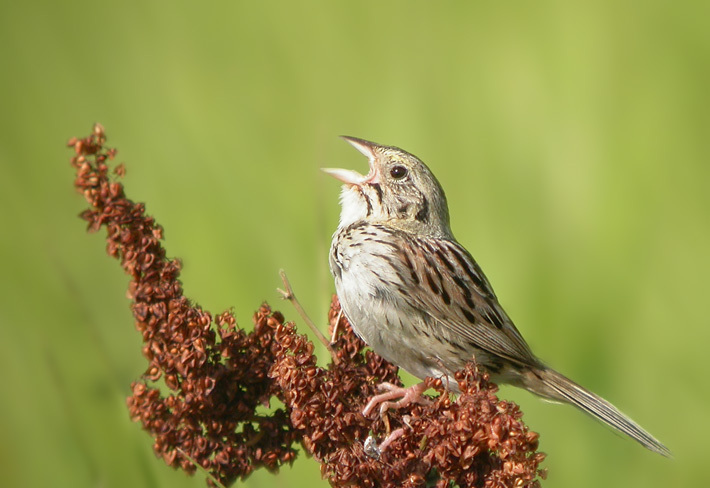Balancing birds and biofuels: Grasslands support more species than cornfields

A Henslow’s sparrow, a bird the Wisconsin DNR includes among its Species of Greatest Conservation Need, perches atop a plant. A new study shows that grasslands support more than three times as many bird species as cornfields.
Photo: Tom Prestby
In Wisconsin, bioenergy is for the birds. Really.
In a study published today in the journal PLOS ONE, University of Wisconsin–Madison and Wisconsin Department of Natural Resources (DNR) scientists examined whether corn and perennial grassland fields in southern Wisconsin could provide both biomass for bioenergy production and bountiful bird habitat.
The research team found that where there are grasslands, there are birds. Grass-and-wildflower-dominated fields supported more than three times as many bird species as cornfields, including 10 imperiled species found only in the grasslands. These grassland fields can also produce ample biomass for renewable fuels.
“Plant diversity is good for wildlife diversity. Our study suggests diverse bioenergy crop fields could benefit birds more so than less diverse fields.”
Peter Blank
Monica Turner, UW–Madison professor of zoology, and study lead author Peter Blank, a postdoctoral researcher in her lab, hope the findings help drive decisions that benefit both birds and biofuels, too, by providing information for land managers, farmers, conservationists and policy makers as the bioenergy industry ramps up, particularly in Wisconsin and the central U.S.
“As bioenergy production demand increases, we should pay attention to the ecological consequences,” says Turner.
This is especially true for grassland birds, as populations of species like the eastern meadowlark, dickcissel and the bobolink have declined in recent decades.
The study began when UW–Madison’s Carol Williams, coordinator of the Wisconsin Grasslands Bioenergy Network, and the DNR’s David Sample approached Turner and asked for her help. They wanted to know: “What are the implications of the decisions we make about how we use our lands?” says Turner.
The research team carefully selected 30 different grassland sites — three of which are already used for small-scale bioenergy production — and 11 cornfields in southern Wisconsin. Over the course of two years, the researchers characterized the vegetation growing in each field, calculated and estimated the biomass yields possible, and counted the total numbers of birds and bird species observed in them.
Lead study author Peter Blank (left) and field assistant Tim Whitby (right) collect biomass from a grassland field for research.
Photo: Amy Uhrin
According to Blank and Turner, the study is one of the first to examine grassland fields already producing biomass for biofuels and is one of only a few analyses to examine the impact of bioenergy production on birds.
While previous studies suggest corn is a more profitable biofuel crop than grasses and other types of vegetation, the new findings indicate grassland fields may represent an acceptable tradeoff between creating biomass for bioenergy and providing habitat for grassland birds. The landscape could benefit other species, too.
Because they are perennial, the grassland fields can also be used year after year, following best management practices that preserve the health of the soil and provide reliable habitat for migratory birds.
“Plant diversity is good for wildlife diversity,” says Blank. “Our study suggests diverse bioenergy crop fields could benefit birds more so than less diverse fields.”
Among the grasslands studied, the team found monoculture grasses supported fewer birds and fewer bird species than grasslands with a mix of grass types and other kinds of vegetation, like wildflowers.
… new findings indicate grassland fields may represent an acceptable tradeoff between creating biomass for bioenergy and providing habitat for grassland birds.
The team found that the presence of grasslands within one kilometer of the study sites also helped boost bird species diversity and bird density in the area.
This is an opportunity, Turner says, to inform large-scale land use planning. By locating biomass-producing fields near existing grasslands, both birds and the biofuels industry can win.
Incentives for a conservation-minded approach could be used to help offset potential differences in profit, the researchers suggest. They also add that the biomass yields calculated in the study may represent the low end of what is possible, given that one of the two study years, 2012, occurred during a significant drought period in the state.
“The study shows species generally really benefit from the practice,” says Blank. “We really can produce bioenergy and provide habitat for rare birds in the state.”
The study was supported by the Wisconsin Department of Natural Resources.
Tags: Bioenergy, conservation, ecology, research, zoology




